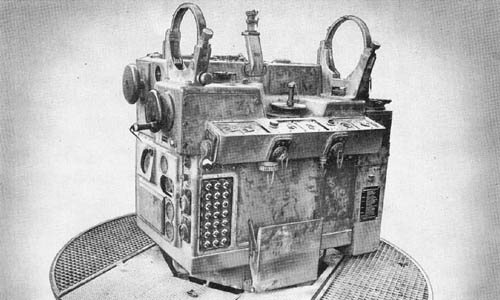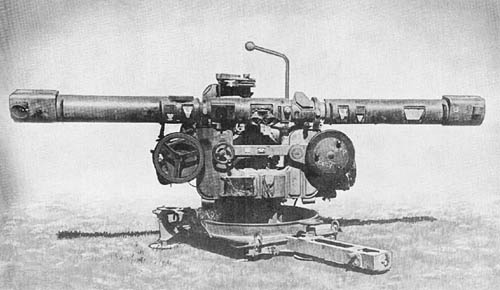
The Kommando-Gerät 40 is a director used principally for major caliber weapons such as the 8.8 cm and 10.5 cm antiaircraft guns. However, by installing the proper ballistic cams, it may be used with any type of gun.
The director is operated by five men. Two are required to track in azimuth and elevation; a third sets in slant range by means of a 4-meter base stereo range finder mounted on the director; the fourth man sets in horizontal angle of approach; and the fifth man operates various switches. Data are transmitted to the guns for reception by a signal-light manual follow-up system. A trailer equipped with devices for lifting the director is used for transport.
The Kommando-Gerät 40 computes continuously Case III data (for invisible targets) by a target speed and angle of approach method, and can handle diving and curving target courses. The time from initial pickup to first round is estimated to be 20 or 30 seconds. When shifting to a new target in the vicinity of the target previously tracked and flying an approximately parallel course, as little as 10 seconds may be required.
A change in course which requires a change in operating procedure upsets firing data for only a few seconds. In principle, the director will predict correctly for a target flying at constant speed with a constant rate of change of altitude and constant curvature. The stability is not affected by gradual changes in course.
After an abrupt change in speed, altitude rate, or course azimuth, about 10 to 15 seconds are required to evaluate the new course.
SPECIFICATIONS
| Azimuth |
|
No limit |
| Elevation |
|
-1.5° to 90.5° |
| Slant range |
|
1,200 to 18,000 m |
| Present horizontal range |
|
570 to 14,500 m |
| Future horizontal range |
|
570 to 14,500 m |
| Future altitude |
|
-500 to 12,000 m |
| Present altitude |
|
0 to 12,000 m |
| Ground speed of target |
|
0 to 300 m/s |
| Vertical speed of target |
|
0 to 200 m/s |
| Horizontal travel during time of flight |
|
0 to 6,000 m |
| Lateral deflection |
|
+/- 1,065 mils |
| Course azimuth correction |
|
+/- 1,600 mils |
| Altitude prediction |
|
+/- 3,000 m |
| Maximum tracking rates |
| Azimuth |
|
+/- 130 mils/sec. |
| Slewing |
|
+/- 700 mils/sec. |
| Elevation |
|
+/- 105 mils/sec. |
| Time of flight |
|
0 to 30 sec. |
| Horizontal parallax |
|
500 m |
| Vertical parallax |
|
+/- 210 m |
| Fuze dead time |
|
0 to 10 sec. |
| Wind velocity |
|
0 to 28 m/s |
| Muzzle velocity |
|
24 numbers (Gebrauchsstufe) |
| dØ |
|
+/- 60/16° |
| dA |
|
+/- 70 mils |
| dF due to dead time |
|
+/- 5 secs. |
| dF due to MV and wind |
|
+/- 5 secs. |
German: p. 176

